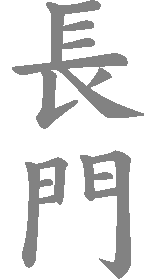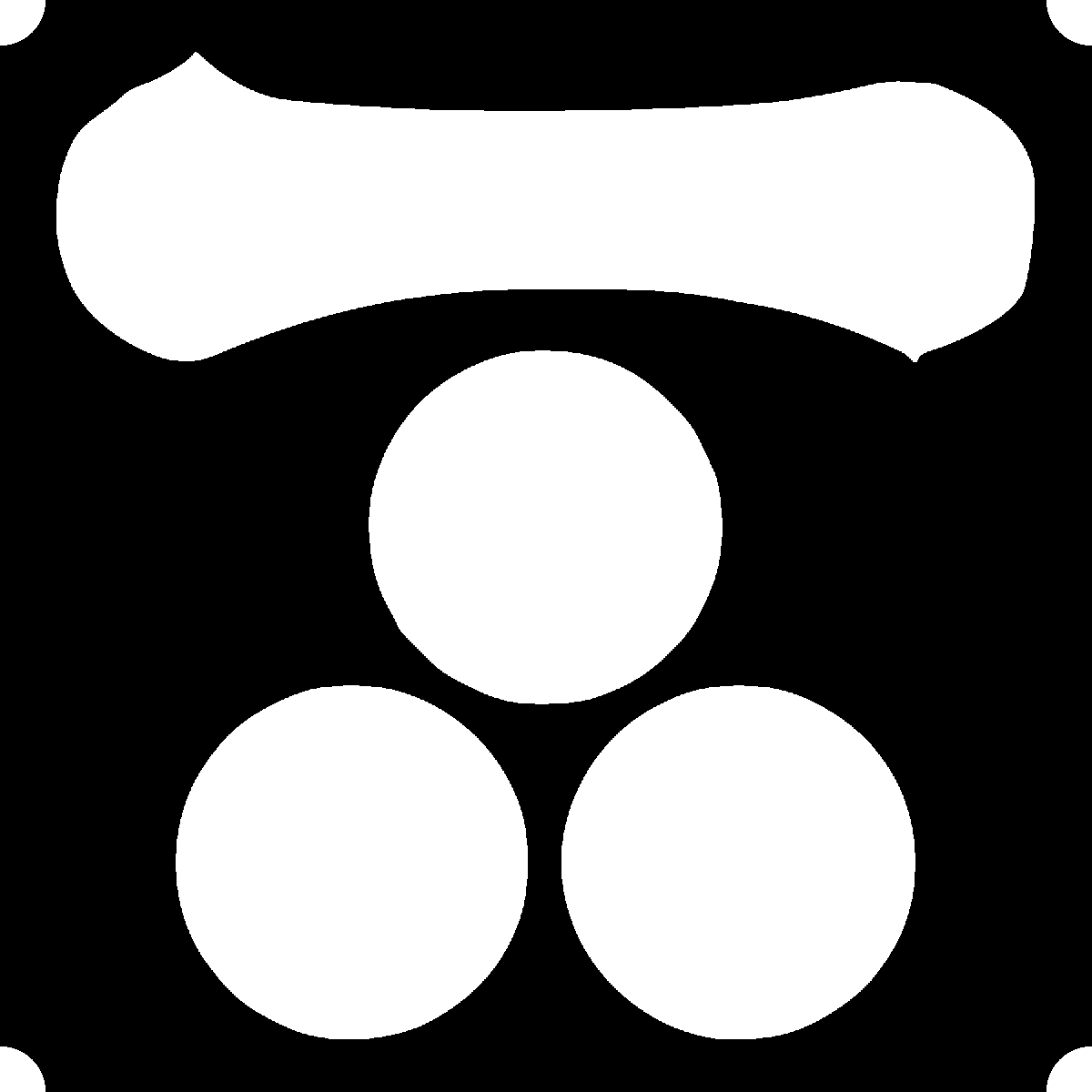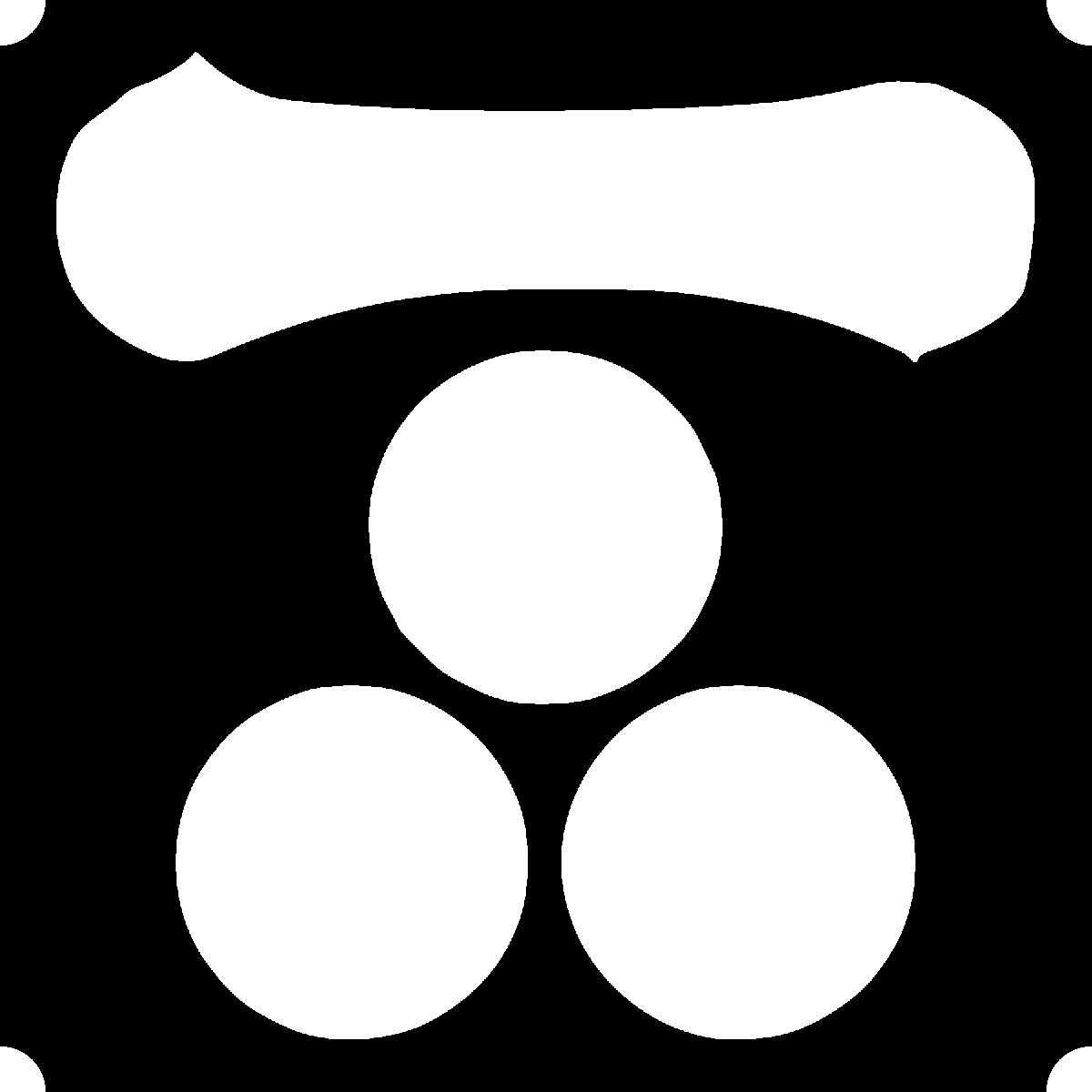|

DAIMYO of
NAGATO PROVINCE
Mori


- Domain: Hagi (Choshu)
- Stipend: 369,000 koku
- Class: Tozama 4
- Headquarters: Hagi Castle
.jpg)
Daimyo family issued from the province of Aki and descended from Oe
Hiromoto (1148-1225).
Senior branch.
Succession
- Suemitsu ( -1221)
- ...
- Tokichika
- ...
- Motonari (1497-1571)
- Takamoto (1523-1563)
- Terumoto (1553-1625)
- Hidenari (1595-1651; daimyo 1623-1651) - 1st Mori daimyo of Hagi
- Tsunahiro (daimyo 1651-1682)
- Yoshinari (daimyo 1682-1694)
- Yoshihiro (daimyo 1694-1707)
- Yoshimoto (daimyo 1707-1731)
- Munehiro (daimyo 1731-1751)
- Shigenari/Shigetaka (daimyo 1751-1782)
- Haruchika (daimyo 1782-1791)
- Narifusa (daimyo 1791-1809)
- Narihiro (daimyo 1809-1824)
- Narimoto (daimyo 1824-1836)
- Naritou (daimyo 1836)
- Takachika (daimyo 1836-1869)
- Motonori (1839-1896; daimyo 1869- )
Notable Ancestors
Son of Hiromoto, the first to take the name of Mori.
Grandson of Suemitsu, settled at Yoshida (Aki).
-
Mori
Motonari (1497-1571)
.jpg)
Descendant of Tokichika in the 9th generation. Resided at Sarukake, in the
district of Tajihi (Aki). Having had a quarrel with his suzerain Amako
Tsunehisa, he joined Ouchi Yoshitaka and fought against him. Ouchi, having
been killed by his vassal Sue Harukata (1551), Motonari entered the lists
against Harukata, defeated and killed him (1555); after this, he gradually
occupied the domains of the Ouchi, besieged Yoshinaga in Yamaguchi (Suwo) and in
1557
conquered the city. At that time, the financial state of the empire
was in such a poor condition that the new emperor Ogimachi had to wait two
years before he could be crowned; in 1560 Motonari took upon himself the
expenses connected with the ceremony and received in acknowledgment of his
services the title of Daizen-tayu and the privilege to bear on his escutcheon
the imperial chrysanthemum and paulownia. Meanwhile, his sons were fighting
for him in all directions: nearly the whole San'yodo and the San'indo were under
his power. War broke out between him and Otomo Sorin, the most poweful of the
Kyushu daimyo, but the Shogun Yoshiteru acted as mediator between them: a
daughter of Sorin was betrothed to the grandson of Motonari, who was to keep
only the castle of Moji (Buzen) in Kyushu. On the other side, the Amako
continued their resistance to their ancient vassal; Motonari invaded Izumo,
and after a long siege occupied the castle of Toda; the last of the Amoko,
Yoshihisa, was confined in Aki, and Motonari became master of ten provinces;
he has, on this account, been called ju-koku no taishu (1566). He was the
father of nine sons; the eldest, Takamoto, having died, Motonari was succeeded
by his grandson, Terumoto.
-
Mori
Takamoto (1523-1563)
Eldest son of Motonari, helped his father in different campaigns, himself
conquered Bitchu and governed the provinces of Nagato, Aki, and Bingo. He died
before his father, at the age of 41.
-
Mori
Terumoto (1553-1625)
.jpg)
Son of Takamoto, succeeded his grandfather Motonari. In 1570, with the help
of his uncles Kikkawa Motoharu and Kobayakawa Takakage, he raised an army
against Amako Katsuhisa and Yamanaka Yukimori, and beseiged them in the castle
of Suetsugu (Izumo). Having heard that his grandfather was dangerously ill, he
left the command of the troops to Motoharu and hastened with Takakage to come
to Motonari. When Suetsugu surrendered, Yukimori was taken prisoner and sent
to Odaka (Hoki), whence he was able to make his escape; Katsuhisa fled to the
Oki islands and from thence went to Kyoto. In 1573 the Shogun Yoshiaki,
deposed by Nobunaga, sought shelter near Terumoto. Nobunaga, displeased,
helped Katsuhisa and Yukimoro and enabled them to carry on the war: they
invaded Tajima, and Yamana Toyokuni joined them; in Inaba, they fortified
themselves in the castle of Tottori. Motoharu marched against them and
Toyokuni surrendered whilst Katsuhisa fortified himself in Wakasa. In 1575,
the
following year, Terumoto brought fresh supplies to Motoharu and
Katsuhisa again entered Tajima. Two years later, Katsuhisa and Yukimori,
re-entered the field, and forming the vanguard of Hideyoshi's army, they
stopped at the castle of Kozuki (Harima); Terumoto came and besieged them;
they were soon reduced to the last extremity and in 1578 Katsuhisa committed harakiri. Meanwhile, Hideyoshi was advancing, and having traversed Inaba, laid
siege to the castle of Takamatsu, defended by Shimizu Muneharu, Terumoto's
vassal. Having stormed the place, he sent the bonze Ankokuji Ekei to Terumoto
to make peace. Whilst the deliberations were pending, Hideyoshi received the
news of the assassination of Nobunaga. He at once invited Muneharu to commit
harakiri, and announced his intention to Terumoto to continue the war:
Takakage however brought his nephew to accept the proposition of peace. In
1587 Terumoto assisted in the Kyushu expedition against the Shimazu. In 1591
he built the castle of Hiroshima and used it as his residence; he now had a
revenue of 1,200,000 koku. Before dying, Hideyoshi chose him as one of
the five Tairo who were to form the regency during the minority of his son
Hideyori. In 1600 he fought against Ieyasu and during the campaign of
Sekigahara, he was intrusted with the castle of Osaka. On the news of the
defeat of his allies, he surendered at once, and to gain favor with the
victor, he went so far as to behead the son of Konishi Yukinaga, who had been
intrusted to him. This shameful villainy did not soften Ieyasu, who took eight
provinces from him, and left him only Nagato and Suwo with a revenue 369,000
koku. Soon after, Terumoto shaved his head, took the name of Sozui, and left
his domains to his son.
-
Mori
Hidenari (1595-1651)
Son of Terumoto, succeeded his father in the government of Nagato and Suwo,
and in 1601 built the castle of Hagi (Hagato), where he resided. In 1608 he
obtained the privilege to bear the name of Matsudaira and the title of Nagato
no kami; at the same time he married an adopted daughter of the Shogun
Hidetada. In 1615 he assisted at the siege of Osaka.
Descendant of Hidenari and, like his ancestor, lord of Nagato and Suwo, was
a distinguished man of letters and wrote several books.
-
Mori
Motonori (1839-1896)
.jpg)
Son of Hiroshige, daimyo of Tokuyama (Suwo). In 1851 was adopted by
Yoshichika, brother and successor of Narihiro. At the time when he assumed the
administration of his domains, the shogunate was endangered; the expulsion of
foreigners and the restoration of the imperial power was the order of the day.
The emperor Komei secretly sent a letter to Motonori, asking his support, and
the protection of Kyoto was intrusted to the two clans of Satsuma and Choshu.
The Shogun Iemochi received orders to expel foreigners and to bring about some
reforms in the government. In 1863, following the instructions he had received,
Motonori ordered his men to fire on the European vessels that passed the
channel of Shimonoseki. Being blamed for such a rash action, he
attributed this disapproval to the influence of the Shogun and in order to
protect the emperor from evil counselors, he resolved to become master of his
person; to that end, a great number of samurai from Nagato assembled in Kyoto,
and soon entered into conflict with the troops of Aizu and Satsuma. The
emperor published an edict, depriving Motonori and Yoshichika of the title of
daimyo and ordering the Shogun to march against Choshu. In the meantime, the
combined forces of the nations concerned in the affair were preparing to
demand satisfaction for the aggression of the preceding year. At that time,
two young samurai of the dreaded clan, were making their way to Yokohama:
their names were Ito Shunsuke and Inoue Bunda. At the time of the aggression
of their prince, they were in England; they left at once, promising to obtain
satisfaction from their daimyo; they obtained a respite of 12 days, but their
efforts remained fruitless: Shimonoseki was bombarded, and Motonori was
obliged to promise an indemnity of 15 million francs and the free passage of
the straits (Sept. 1864). Meanwhile the Shogun had given orders to the
neighboring daimyo to attack the rebel: assailed at the same time from three
sides, Choshu was everywhere victorious (1865-1866). Shortly after, the Shogun
died suddenly at Osaka (Sept. 1866); the emperor Komei soon followed him to
the grave (Feb. 1867), and the expedition against Nagato was abandoned.
Related Branches
- Junior branch: Tokuyama (Suwo -- 30,000 koku)
- Branch: Chofu (Nagato -- 50,000 koku)
- Branch: Kiyosue (Nagato -- 10,000 koku)
Sources
Mori


- Domain: Chofu/Fuchu
- Stipend: 50,000 koku
- Class: Tozama 5
- Headquarters: Chofu Castle
Daimyo family issued from the province of Aki and descended from Oe
Hiromoto (1148-1225).
Branch which resided at Chofu.
Succession
- Suemitsu ( -1221)
- ...
- Tokichika
- ...
- Motonari (1497-1571)
- Motokiyo
- Hidemoto (1579-1650) - 1st Mori daimyo of Chofu
- Mitsuhiro
- Tsunamoto
- Mototomo
- Motonori
- Masahiro
- Morotaka
- Masataka
- Masamitsu
- Masayoshi
- Motoyoshi
- Motoyuki
- Motochika
- Mototoshi
Notable Ancestors
Son of Hiromoto, the first to take the name of Mori.
Grandson of Suemitsu, settled at Yoshida (Aki).
-
Mori
Motonari (1497-1571)
.jpg)
Descendant of Tokichika in the 9th generation. Resided at Sarukake, in the
district of Tajihi (Aki). Having had a quarrel with his suzerain Amako
Tsunehisa, he joined Ouchi Yoshitaka and fought against him. Ouchi, having
been killed by his vassal Sue Harukata (1551), Motonari entered the lists
against Harukata, defeated and killed him (1555); after this, he gradually
occupied the domains of the Ouchi, besieged Yoshinaga in Yamaguchi (Suwo) and in
1557
conquered the city. At that time, the financial state of the empire
was in such a poor condition that the new emperor Ogimachi had to wait two
years before he could be crowned; in 1560 Motonari took upon himself the
expenses connected with the ceremony and received in acknowledgment of his
services the title of Daizen-tayu and the privilege to bear on his escutcheon
the imperial chrysanthemum and paulownia. Meanwhile, his sons were fighting
for him in all directions: nearly the whole San'yodo and the San'indo were under
his power. War broke out between him and Otomo Sorin, the most poweful of the
Kyushu daimyo, but the Shogun Yoshiteru acted as mediator between them: a
daughter of Sorin was betrothed to the grandson of Motonari, who was to keep
only the castle of Moji (Buzen) in Kyushu. On the other side, the Amako
continued their resistance to their ancient vassal; Motonari invaded Izumo,
and after a long siege occupied the castle of Toda; the last of the Amoko,
Yoshihisa, was confined in Aki, and Motonari became master of ten provinces;
he has, on this account, been called ju-koku no taishu (1566). He was the
father of nine sons; the eldest, Takamoto, having died, Motonari was succeeded
by his grandson, Terumoto.
Son of Motonari, was adopted when yet a child by the Hoida family, whose
name he took. He fixed his residence in the castle of Sarukake (Bitchu). In
1577 he made a campaign in Sanuki, then, together with his brother Motoharu
and Takakage, he fought against Amakok Katsuhisa and against Ukita Naoie. In
1583 he established himself in the castle of Yamanaka, again assumed the name
of Mori, and received the title of Iyo no kami. He attended the expedition to
Korea.
Mori
Hidemoto (1579-1650)
Son of Motokiyo, first bore arms in the war against the Hojo of Odawara
(1590), and took part in the expedition to Korea. He returned a little before
the death of Hideyoshi and received a revenue of 200,000 koku in the provinces
of Nagato, Suwo, and of Fuchu (Nagato -- 50,000 koku). Hidemoto is often
called Toyoura no Sangi.
His descendants resided at Fuchu (or Toyoura).
Related Branches
- Senior branch: Hagi (Choshu) (Nagato -- 369,000 koku)
- Junior branch: Tokuyama (Suwo -- 30,000 koku)
- Branch: Kiyosue (Nagato -- 10,000 koku)
Sources
Mori


- Domain: Kiyosue
- Stipend: 10,000 koku
- Class: Tozama 5
- Headquarters: Municipal office
Daimyo family issued from the province of Aki and descended from Oe
Hiromoto (1148-1225).
Branch which resided at Kiyosue.
Succession
- Suemitsu ( -1221)
- ...
- Tokichika
- ...
- Motonari (1497-1571)
- Motokiyo
- Hidemoto (1579-1650) - 1st Mori daimyo of Chofu
- Mitsuhiro
- Tsunamoto
- Mototomo - 1st Mori daimyo of Kiyosue
- Motohira
- Masanari
- Masakuni
- Masaaki
- Motoyo
- Mototsugu
- Motozumi
Notable Ancestors
Son of Hiromoto, the first to take the name of Mori.
Grandson of Suemitsu, settled at Yoshida (Aki).
-
Mori
Motonari (1497-1571)
.jpg)
Descendant of Tokichika in the 9th generation. Resided at Sarukake, in the
district of Tajihi (Aki). Having had a quarrel with his suzerain Amako
Tsunehisa, he joined Ouchi Yoshitaka and fought against him. Ouchi, having
been killed by his vassal Sue Harukata (1551), Motonari entered the lists
against Harukata, defeated and killed him (1555); after this, he gradually
occupied the domains of the Ouchi, besieged Yoshinaga in Yamaguchi (Suwo) and in
1557
conquered the city. At that time, the financial state of the empire
was in such a poor condition that the new emperor Ogimachi had to wait two
years before he could be crowned; in 1560 Motonari took upon himself the
expenses connected with the ceremony and received in acknowledgment of his
services the title of Daizen-tayu and the privilege to bear on his escutcheon
the imperial chrysanthemum and paulownia. Meanwhile, his sons were fighting
for him in all directions: nearly the whole San'yodo and the San'indo were under
his power. War broke out between him and Otomo Sorin, the most poweful of the
Kyushu daimyo, but the Shogun Yoshiteru acted as mediator between them: a
daughter of Sorin was betrothed to the grandson of Motonari, who was to keep
only the castle of Moji (Buzen) in Kyushu. On the other side, the Amako
continued their resistance to their ancient vassal; Motonari invaded Izumo,
and after a long siege occupied the castle of Toda; the last of the Amoko,
Yoshihisa, was confined in Aki, and Motonari became master of ten provinces;
he has, on this account, been called ju-koku no taishu (1566). He was the
father of nine sons; the eldest, Takamoto, having died, Motonari was succeeded
by his grandson, Terumoto.
Son of Motonari, was adopted when yet a child by the Hoida family, whose
name he took. He fixed his residence in the castle of Sarukake (Bitchu). In
1577 he made a campaign in Sanuki, then, together with his brother Motoharu
and Takakage, he fought against Amakok Katsuhisa and against Ukita Naoie. In
1583 he established himself in the castle of Yamanaka, again assumed the name
of Mori, and received the title of Iyo no kami. He attended the expedition to
Korea.
Mori
Hidemoto (1579-1650)
Son of Motokiyo, first bore arms in the war against the Hojo of Odawara
(1590), and took part in the expedition to Korea. He returned a little before
the death of Hideyoshi and received a revenue of 200,000 koku in the provinces
of Nagato, Suwo, and of Fuchu (Nagato -- 50,000 koku). Hidemoto is often
called Toyoura no Sangi.
His descendants ersided at Fuchu (or Toyoura).
Related Branches
- Senior branch: Hagi (Choshu) (Nagato -- 369,000 koku)
- Junior branch: Tokuyama (Suwo -- 30,000 koku)
- Branch: Chofu (Nagato -- 50,000 koku)
Sources
|
